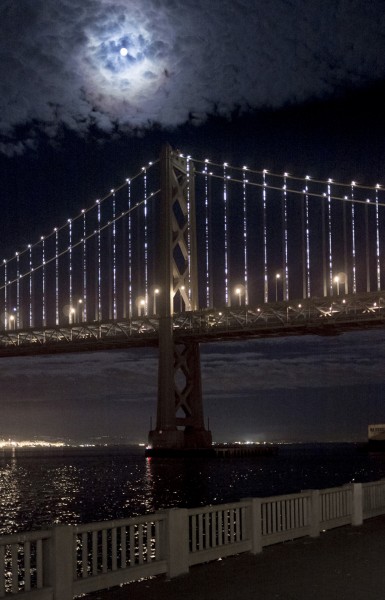Public-private partnership between Illuminate the Arts, CalTrans & artist Leo Villareal turns bridge into The Bay Lights sculpture: 4.5 miles of LED supported by solar; spurs local economy
In a shining example of public-private partnership, The Bay Lights, the new LED lighting system for the Bay Bridge that was developed by Philips Color Kinetics, has been gone to live since May. Fulfilling the brainchild of Ben Davis, chairman of Illuminate the Arts (ITA) and the vision of acclaimed artist Leo Villareal, the bridge will become a one-of-a-kind lighted sculpture for the next two years. Installed with the support of the California Department of Transportation (Caltrans), the bridge is expected to be viewed by over 50 million people and bring nearly USD$ 100 million in revenue to the local San Francisco economy. The new LED lighting system uses 85 percent less energy than traditional lighting technologies, energy that will be offset by dedicated solar panels set up in Davis, CA by CleanPath.
Villareal, creator of The Bay Lights, is a pioneer in the use of LED lights and computer driven imagery using Philips Color Kinetics eW Flex SLX product in 4200 Kelvin correlated color temperature for the Bay Lights project. eW Flex SLX is a versatile strand of individually controllable white light LED nodes. The durable, flexible form factor allows dynamic points of white light to be installed across nearly any interior or exterior surface which made it an ideal choice for The Bay Lights project. Philips Color Kinetics worked with Villareal to create custom spacing between the nodes to accommodate his design. In the end, almost 4.5 miles of product was installed on the bridge, roughly equal to the total length of the Bay Bridge, counting both spans. The lighting will be viewable from San Francisco and points north, but not by drivers crossing the bridge.
-

-
Philips LED Technology Helps Shine Light on the Bay Bridge as Sustainable Art.
“Using Philips LED technology really gives me the creative flexibility I need to bring this bridge to life and fulfill my vision,” said Leo Villareal. “This isn’t about just lighting another bridge with white or colored light. The Bay Lights emphasizes the use of ‘intelligent’ lighting, fully utilizing individual control and the ability to create 255 levels of brightness per node. The custom software I have created allows for the creation of ever changing patterns site specifically created for this location with the goal of producing a work of art.”
Turning the bridge into a monumental light sculpture is a unique application of LED lighting technology that sets the Bay Bridge apart. Villareal networked 25,000 of these LED nodes to create complex algorithms and patterns across the bridge’s western span. These patterns dynamically recombine themselves over the two-year duration of the installation, transforming the bridge into a living piece of art which organizers believe to be the world’s largest LED light sculpture.
“The Bay Lights is a prime example of how LED technology can create meaningful value for a community in an environmentally friendly way,” said Bruno Biasiotta, CEO and president of Philips Lighting Americas. “As lighting and technology converge, we push the boundaries of how we interact with light and start to see the art of what is possible. Through the tireless work of ITA, Leo Villareal and CalTrans, the residents of San Francisco will have a stunning new piece of artwork that honors the city’s devotion to the arts and inviting visitors to see what else this fantastic city has to offer.”

Organizers of The Bay Lights have provided all the financial support for the project through private funding, not tax payers. Over the course of the year, it will cost approximately $11,000 in energy to light the piece, which translates into $30 per day or $4.25 per hour.














